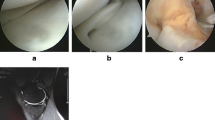Abstract
In this study, we aim to evaluate the arthroscopic findings of meniscal bucket handle tears and to correlate them with the proposed MR imaging signs of meniscal bucket handle tears suggested in the literature. Thirty-six patients who had a diagnosis of bucket handle tear in arthroscopy, in either medial or lateral meniscus, were included in our study (32 males and 4 females). Meniscal tears were evaluated in arthroscopy according to Dandy’s classification. The MRIs were retrospectively analyzed regarding the following findings: absence of bow tie sign, presence of double posterior cruciate ligament (PCL) sign, double anterior horn sign, flipped meniscus sign, disproportional posterior horn sign, and fragment within the intercondylar region. Locked types I and II fragment of medial meniscus and half-length, whole-width and whole length–half-width fragment of lateral meniscus in arthroscopy were basically correlated with fragment within the intercondylar notch and absent bow tie signs in MRI. We did not find the double PCL sign in any of the patients with a lateral meniscal bucket handle tear. The most common signs in MR images of meniscal bucket handle tears were the fragment in the notch sign and the absent bow tie sign. They were observed with equal frequency of 88.8%. The presence of double PCL sign, double anterior horn sign, flipped meniscus sign, disproportional posterior horn sign were less common (41.66, 33, 25, and 27.7%, respectively). We conclude that the presence of at least two of the six MRI signs should be regarded as highly suggestive for bucket handle tears of menisci.








Similar content being viewed by others
References
Chen HC, Hsu CY, Shih TT, Huag KM, Li YW (2001) MR imaging of displaced meniscal tear of the knee: importance of a “disproportional posterior horn sign”. Acta Radiol 42:417–421
Dandy DJ (1990). The arthroscopic anatomy of symptomatic meniscal lesions. J Bone Joint Surg Br 72:628–633
Fisher SP, Fox JM, Del Pizzo W, Friedman MJ, Snyder SJ, Ferkel RD (1991) Accuracy of diagnoses from magnetic resonance imaging of the knee. A multi-center analysis of one thousand and fourteen patients. J Bone Joint Surg Am 73:2–10
Haramatti N, Staron RB, Kierman H (1993) The flipped meniscus sign. Skeletal Radiol 22:273–277
Helms CA, Laorr A, Cannon WD (1998) The absent bow tie sign in bucket handle tears of the menisci in the knee. Am J Roentgenol 170:57–61
Jackson DW, Jenning LD, Maywood RM, Berger PE (1988) Magnetic resonance imaging of the knee. Am J Sports Med 16:29–38
Magee TH, Hinson GW (1998) MRI of meniscal bucket handle tears. Skeletal Radiol 27:495–499
Mandelbraum BR, Finerman GA, Reicher MA, Hartzman S, Bassett LW, Gold RH, Rauschning W, Dorey F (1986) Magnetic resonance imaging as a tool for evaluation of traumatic knee injuries. Am J Sports Med 14:361–370
Polly DW, Callachan JJ, Sikes RA, McCabe JM, McMahon K, Savory CG (1988) The accuracy of selective magnetic resonace imaging compared with the finding of arthroscopy of the knee. J Bone Joint Surg Am 70:192–198
Reicher MA, Hartzman S, Duckwiler GR, Bassett LW, Anderson LJ, Gold RH (1986) Meniscal injuries: detection using MR imaging. Radiology 159:753–757
Ruff C, Weingardt JP, Russ PD, Kilcoyne RF (1998) MR imaging patterns of displaced meniscus injuries of the knee. Am J Roentgenol 170:63–67
Shakespeare DT, Rigby HS (1983) Bucket handle tear of the meniscus. J Bone Joint Surg Br 65:383–387
Silva I, Silver DM (1988) Tears of the meniscus as revealed by magnetic resonance imaging. J Bone Joint Surg Am 70:199–202
Stäbler A, Glaser C, Reiser M (2000) Musculoskeletal MR: knee. Eur Radiol 10:230–241
Weiss KL, Morehouse HT, Levy IM (1991) Sagittal MR images of the knee: low signal band parallel to the posterior cruciate ligament caused by a displaced bucket-handle tear. Am J Roetgenol 156:117–119
Wright DH, De Smet AA, Norris M (1995) Bucket handle tear of the medial and lateral menisci of the knee: value of MR imaging in detecting displaced fragments. Am J Roentgenol 165:621–625
Watt AJ, Halliday T, Raby N (2002) The value of absent bow tie sign in MRI of bucket handle tears. Clin Radiol 55:622–626
Aydingöz Ü, Firat AK, Ahmet Atay O, Nedium Doral M (2003) MR imaging of meniscal bucket handle tears: a review of signs and their relation to arthroscopic classification. Eur Radiol 13:618–625
Author information
Authors and Affiliations
Corresponding author
Rights and permissions
About this article
Cite this article
Ververidis, A.N., Verettas, D.A., Kazakos, K.J. et al. Meniscal bucket handle tears: a retrospective study of arthroscopy and the relation to MRI. Knee Surg Sports Traumatol Arthrosc 14, 343–349 (2006). https://doi.org/10.1007/s00167-005-0678-x
Received:
Accepted:
Published:
Issue Date:
DOI: https://doi.org/10.1007/s00167-005-0678-x




